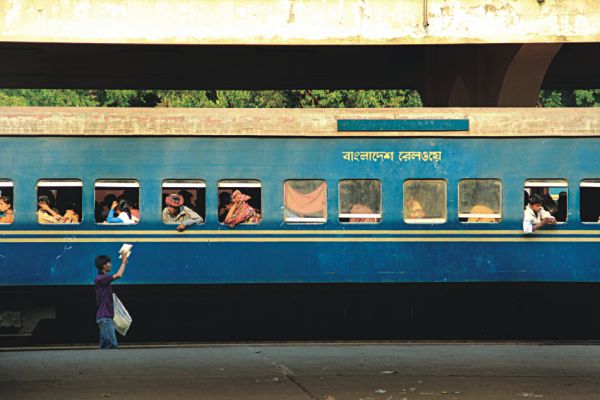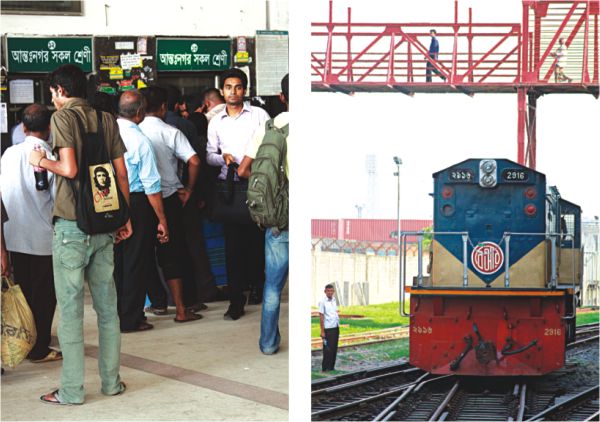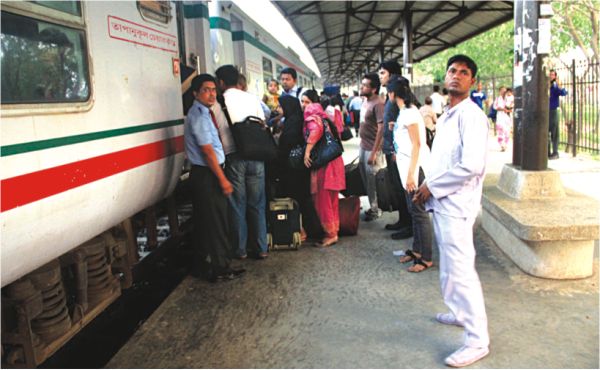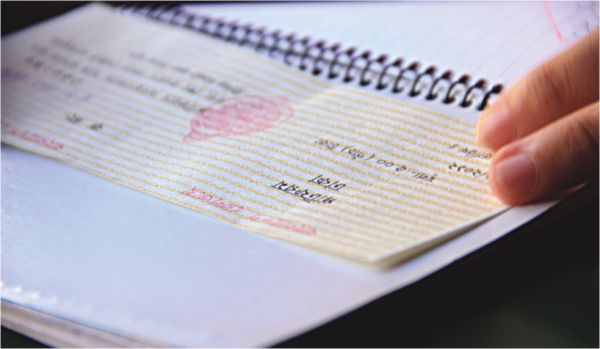| Spotlight

An Easy Transport
Sumaiya Ahsan Bushra
Photos:Kazi Tahsin Agaz Apurbo
“The year 2011 witnessed the existing population of 148,000,000 people.
The population growth rate increases every year quite significantly.
The total area of Bangladesh according to wikipedia is 56,977 sq mi.”
These are just some facts and figures we come across everyday. Every year, the situation worsens, as it is not remotely possibly to control the population and match it with the existing total area of the country. In a condition such as this, the country is at stake. Not only are there various problems within the country but major obstacles are created to accommodate this massive number of people. Thereby, as the number of people keeps increasing, the numbers of private vehicles increase proportionately. This creates one of the major issues the country, at present, is facing. Traffic jam, as the modest citizens of Bangladesh refer to it, is a concern for all. Each time we step out of our homes, we come across this phenomena, which have and remains an unalterable factor ruling our lives. To resolve this predicament, several solutions have been proposed, amongst which introducing a flexible railway system is one.

Some students use the inter city train to get to university faster.
According to a research conducted by Syed Arafat Ali, a student of Dhaka University, there has been a massive impact on the economy of our country due to traffic congestion. The research findings state that, the estimated loss is more than half of the country's total annual development outlet and one fourth of the revenue collection target for current fiscal year. It is really bizarre to see a figure like 96 billion taka ($1.53 billion) being wasted due to traffic jam. Another alarming fact is that Dhaka is at standstill for an average 7.5 hours a day. The actual cost we bear due to traffic congestion are travel time cost, cost of excess fuel burnt, revenue loss by passenger transport operators, environment damage and cost of traffic accidents.
Taka 19,555 core ($ 3 billion) financial loss including wasted time on roads for nearly 11896, environmental cost 2200 crore, and business loss of passenger transport and freight industries of the 2000 crore. Excess fuel eats up 575 crore and accidents 50 crore. The study states that 3.2 million business hours are lost everyday. Therefore, as a proposal to dissolve this problem a simple metro system can be established.

An uncertainity remains as students wait for a prolonged period of time for the train to arrive.
The railway system has been quite an easy way to commute for several people from all walks of life. Particularly, for students who live far away, using this system is an option. Using the railway saves time for some. In some situations, there are students who cannot avail the hostel facilities in their universities and are obliged to travel a large distance to reach their destination. For them, this is a perfect solution even though there are pitfalls in this system as well. Arafat, an MBA student from Dhaka University, who lives in Uttara explains, “It is almost impossible to consider taking a train to travel to university. This is not feasible because, there is no existing train system as such in Bangladesh. There is no intra-city train. We do not even know when the train will come. At times, there have been situations where my friends had to wait for a very long time for the train to come. This is not time saving at all. Living in Dhaka, we come face to face with uncertainty day in and day out.”
While on the contrary, another student of a private university, points out briefly that the train system could be utilised and there are positives to it. “I live near Kamlapur railway station, so it hardly takes me a few bucks to get to the station. I buy a platform ticket for 5 taka, board a train and go till Uttara in a span of maximum 25 minutes. Since my university does not have a hostel or a residential facility, I consider this the cheapest way to get to university. Yes, there are problems caused at times when the train arrives late, but then if I took any other mode of transport, I would be at loss altogether.”

A crowded line always stands as an obstacle.
Keeping this railway system in mind as a fast mode of transport, students from public universities and other research organisations have compiled reports for the establishment of intra-city train system just for a selective audience, which includes students, officers and professionals. Even though, several resourceful organisations have reported that the Bangladesh Railway (BR) has been one of the least sought avenues for government job seekers and cadres, therefore, the 150 year old situation might not change over night. Unless a solution is found by the young minds of the nation, regarding policy making issues of BR.
Also, findings have shown that many people are not aware of the fact that the Army faction of BR authorities had taken a few steps seven years back, which could have been extremely beneficial in this regard. The cantonment railway service runs from Uttara along the western side of the airport and from Karwan Bazaar the existing railway is extended to Bangla Motor, Kakrail and Bongobazar. During the early years of its inception, this system received an excellent feedback. But due to lack of promotion and security issues, especially for women, less people were inclined to use it.
The existing system is not bad altogether. The inter-city trains are quite popular and very affordable. These are the ones which are conveniently used by all members of the society (students and professionals) to commute from one part of the city to another. Two types of trains are there-- one which is considerably modern like the shuborno express and then there are the local trains (which travel from Kamlapur to Jaidevpur and other alternative routes six times a day). However, there are some complicated issues involved in this matter as well, regarding using some of these trains as a means of transport. As one of the security personnels of one of these trains state, “No students are allowed on this train to travel. Only railway staff members are allowed.” Therefore, confusion remains in this area, whether this is actually legal or not.

Fresh graduates opt for this mode of transport.
Further on, in a conversation with the station Manager at Kamlapur railway station, he explains the situation at current. “We have a monthly ticket system, which costs taka 300 for passengers who wish to travel by train. This facility has been there for a long time but in recent times, (since September 2011), we have taken strict initiatives to implement this system. Previously, the passengers (students and professionals) would travel without a ticket which would create a difficulty for us. So in order to re-organise the structure we have come up with this plan.”
However, what could be proposed might be far fetched yet possible to achieve if a combined voice can come out from the youth of the nation. This is a system of introducing a railway, which is solely dedicated to students of all levels. It has been witnessed time and again that influential members of student union play a role in these matters. This should be prevented as well, as conflict and unrest has been created amongst the students. Thereby, a solution, which does not involve any such dirty politics and is clean and secure should be put forward.
A number of students have made several propositions on this issue. Adnan Firoze states, “If an intra city train service with good promotion and proper security can be established, even as a pilot, it is bound to pull students of all levels.” He adds, “Besides, a new venture in transportation is more feasible than the utopian (till now) metro rail. Even better news is, if refurbishing the system can be done, other brands will participate in a new venture of advertising and promotion using the railway which may indeed transform this debtor avenue into a profitable one.”
In addition, Arafat states, “For students, an intra-city train system can be proposed which will shift at least 20 percent of the bus passengers and decrease traffic jams to some extent. This system does not have to be an ultra modern subway system. It could be done using an existing train which would carry passengers from different routes within Dhaka, for instance, from Mirpur to Uttara.” Arafat further explains, “This will be an economically beneficial method and less time consuming as well. In the long term, this will leave a positive impact on the economy of the country and increase productivity as more people will be comfortable using the train."
Traffic congestion decreases productivity and has an adverse effect on our economy. Dhaka is the heart of the country where all business transactions are made. Time is a valuable aspect and therefore, every minute counts. In a situation as such, important work like travelling to university on time is essential. If a 'non fictional' railway system could be established, then there is a probability that the load on the increasing number of problems that the country already has, at present, might decrease.

A platform ticket is a must in order to get into an inter-city train.
|
